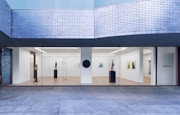変化とは新しさだ
imma ヴェイヤンさんが初めて来日されたのは1998年と伺いました。それ以来日本と強いつながりがあったそうですが、初来日の際の経験はどういったものでしたか? また日本での経験はご自身のアートにどのような影響を与えたのか教えて下さい。日本の技術やテクニックのなかでとくに関心があるものはありますか?
グザヴィエ・ヴェイヤン(以下、ヴェイヤン) 日本を初めて訪れたのは1998年、妻と生まれて間もない息子を引き連れてのことでした。とても刺激的な体験で、そのすべてを満喫しました。当時、私たちは京都のヴィラ九条山に滞在し、観光客らしく自転車で寺巡りをしたものです。滞在時には日本の人々の夏の日常的なリズム──それは静寂と力強さを兼ね備えたものでした──をも感じ取ることができました。
この旅が私にとって特別なものとなったのは、電車や駅といった公共サービスから伝統的な手工芸に至るまで、日本社会やモノの質の高さを知ることができた点にあります。日本のテクノロジーと伝統の融合は私にとって大きな衝撃であり、影響を与えられました。もうひとつ、とくに印象に残ったのが彩色の美学です。例えば様々な種類のベージュやブロンズなど、日本の色彩は非常に落ち着いており、とても好きになりました。

imma ヴェイヤンさんは、20 年以上も前からコンピューターを用いた作品を制作されており、テクノロジーを駆使するという点において非常に先駆的です。作家活動においてテクノロジーの役割はどのように進化してきましたか? とくに近年、進化のスピードがとにかく早いですが、ご自身にも何か顕著な変化はありましたか?
ヴェイヤン 確かに私はテクノロジーが大好きですが、コンピューターオタクではありません。面白いことに、こうした件についてアドバイスできると思われがちですが、じつはスマホの操作もままならないのですよ。しかしもちろん、技術というものには大きな関心を寄せています。なぜなら技術とは、環境に関わる方法のひとつだからです。技術的なものを活性化させることとは、すなわち環境に触れることなのです。
私が活動を開始してから、物事は大きく変化しました。例えば、私がパリに初めて持ったスタジオにはFAXしかありませんでした。ここ30年の私たちの進化は驚くべきものです。進化の良し悪しを問うているのではありません。私にとって、すべての変化は本質的に良いものです。なぜなら、変化とは新しさであり、新しいものはすべて考慮と尊重されるべきだからです。

アートの存在は“コーザ・メンターレ(cosa mentale)”
imma ヴェイヤンさんの作品には、三次元のポートレートがありますね。実在する人物の個人的な特徴や属性が排除され、より抽象的で普遍的な像へと展開されながらも、その人のもつ雰囲気など個人としての存在感が残っている、とても不思議な感覚です。このようなプロセスを踏む背景にはどのような意図があるのでしょうか。
ヴェイヤン 私の人物像へのアプローチは、空間内での存在のしかたや、人々がその存在をどのように感じるかということに重きを置いています。それはとても不可思議なものです。私にとって部屋や公共空間にいる人物の存在感の強さというものは、大きな謎を秘めています。私は作品を通して、その本質をとらえようとしていますし、その人を特定かつ一般的な存在にしているものは何かを考えています。ビジュアルがかすみ消えゆくことで、“誰か”と“何か”の境界線の限界に到達するようにする。つまり、何が人間で何が人間ではないのかを見極める試みなのです。

imma 現在、世の中ではアート、ファイナンス、サイエンスなど様々な側面でリアルとバーチャルの境界園が更新されています。そのようななかで、ヴェイヤンさんは、個としてのアイデンティティのあり方についてどのような考えをお持ちですか?
ヴェイヤン この問いは、現在活動しているすべてのアーティストにとっての大きな課題だと思います。にもかかわらず、例えばヴィデオゲームの世界について、あたかも現実と混同されるものかのように否定する人がいることには、いまだに驚かされます。私たちは、現実とそうでないものの見極めを難なくできると思うのです。
アーティストとしての私たちは、モノや状況を現実の環境にはめ込もうとしています。私にとってアーティストの役割とは、現実世界とバーチャルな世界双方において、自身のリアリティを盛り込む適切な場所を見つけることです。私の好きな言い方は、アートの存在は“コーザ・メンターレ(cosa mentale)”つまり精神的なものであるということです。そして、それを“現実のもの”とすることが目標なのです。
imma SNSによる発信の増加に伴い、現在アートがより活性化されていると感じます。そうしたなかで多種多様なアートが生まれており、昨今ではARやVR、デジタルデータ、バーチャル上の価値がNFTで売買されています。その点についてどう思いますか?
ヴェイヤン 当然ながら、世界の新しいテクノロジーや新しい領域、とくにアート界のそれにはつねに注目しています。NFTにはとても驚かされ、VRには大きな期待を寄せています。また、ソーシャルネットワークは間違いなくアーティストが活用すべき場です。しかし、バーチャルな世界の力強さが、私たちにとって現実のモノや状況との対峙をより価値あるものにしていることには驚かされます。私は、現実の力が弱まってきているとは思いません。展覧会を訪れることは、いまもなお、非常に力強い体験をもたらします。空気の質、その部屋に置かれた作品や人との関係性の質、音......こうしたことは、今日のバーチャル体験には含まれていないのです。
imma すごく理解できます。バーチャルとリアルの違いはとても興味深くあたし自身も感じています。とても面白いお話ありがとうございました!

- 1
- 2

























